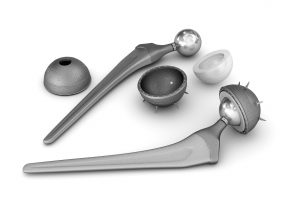It’s a great question. And I’m glad I asked it for you. Now let me answer it. There are several ways to identify the specific medical device implanted in your body. (A medical device is any manufactured device–like an artificial hip–implanted in the body for the purpose of resolving an injury, curing disease, or improving a person’s health. Medical devices can be artificial joints like hips and knees and shoulders, heart stents and pacemakers, IVC filters, hernia mesh, and hundreds of other examples.) Some ways of identifying exact product components are better than others. Identifying the medical device several different ways is the best of all.
Product Stickers: The Gold Standard
It all sort of starts with “product stickers.” These are the identifying stickers that are attached to the box containing the medical device, and they can be peeled off and affixed to a nurse’s hospital note or to another page in the hospital or surgeon’s record for the implant surgery. It goes something like this: the representative for the device maker shows up with the artificial hip components (or other medical device). The surgical nurse or the surgeon will double check that the components are the precise ones needed for the surgery, scan them into the system and note them in the record. The nurse will then peel off the product stickers and attach them to the hospital record and include them with all the other pages of documents explaining details of the surgery. The image at right is an approximation of what the stickers will look like: a bar code, the name of the manufacturer, the specific product name, the Lot and Reference numbers, and other identifying information.
Hospital Records: Typed Identification of Specific Components
For some reason, not all hospitals and surgery centers keep product stickers. Some simply throw them out with the boxes. It is not a good practice, but it happens. In those cases the person responsible for identifying the components usually types in the specific lot and reference numbers and other identifying information for each device component used in the surgery.
Operative Report
In any surgery the surgeon always writes up (usually dictates) an Operative Report where he or she describes what occurred during the surgery. In this report the doctor will explain the procedure and will reference the components used and implanted. In another section of this report, titled something like “Implants,” the doctor will list the specific components, with complete names and actual sizes.
Explants: Preserving and Keeping the Actual Device Removed From Your Body
The actual gun used in an armed robbery is better evidence than a description or a photo of the gun. The same holds for a product liability case involving a failed medical device. That’s why you should do all that you can to “preserve evidence” by making sure your surgeon understands you want to preserve and maintain any components removed from your body (“explants”). I wrote extensively about preserving explants here, and I invite you to read that article, but in a nutshell you need to send a letter to your physician asking her or him to preserve all evidence, especially explanted medical devices following the surgery. With written notice in advance, the doctor and the hospital usually understand the drill and will preserve the removed components, usually by sending the explanted components to the pathology department to hold the components for the patient or the patient’s attorney.
Surgeon’s Affidavit
As you can imagine, lawyers representing companies that sell defective medical devices will use every advantage to derail your case. If defense lawyers can cast doubt on what device is in your body, then you as the injured person cannot win your case. In some instances the product stickers were not maintained with the hospital records and the explanted components were not preserved. In that case, even with the typed identification of the products (see Hospital Records, above), you may need to obtain a signed and sworn affidavit from the surgeon testifying to the exact components implanted in your body. I have used this technique in the past and it has worked well.
Get Help From a Good Product Liability Lawyer
I’ve written about this subject on this site so often I’m not even going to link you to the other articles (they are easy to find). But I will say this: you need to work with an experienced product liability lawyer on any defective medical device case, and preferably before you undergo revision surgery (for several reasons, but mainly so the attorney can communicate with the surgeon and the hospital in advance about preserving all relevant evidence).
Identifying your medical device is very important. Being legitimately injured by a defective product is not enough. You have to show what product injured you. If you can’t, you don’t even know which medical device maker to sue. Put obviously: you cannot sue DePuy Orthopaedics for a defective Smith & Nephew artificial hip. So it is vital that you identify the exact components that injured you, in as many ways as possible. Good luck.
 North Carolina Product Liability Lawyer Blog
North Carolina Product Liability Lawyer Blog




